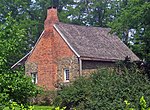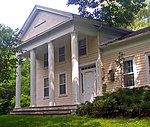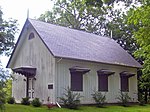Charles H. Coons Farm
Columbia County, New York Registered Historic Place stubsFarms on the National Register of Historic Places in New York (state)Historic districts on the National Register of Historic Places in New York (state)Houses completed in 1880Houses in Columbia County, New York ... and 3 more
Italianate architecture in New York (state)NRHP infobox with nocatNational Register of Historic Places in Columbia County, New York
Charles H. Coons Farm, also known as the Prospect Fruit Farm, is a historic home and farm and national historic district located at Germantown, Columbia County, New York. The main farmhouse was built about 1880, and is a two-story, rectangular frame dwelling with Italianate style design elements. It sits o s stone foundation and has an intersecting gable roof. The front facade features a full-width verandah. Also on the property are the contributing New World Dutch Barn and attached shed (c. 1810), Horse Barn (c. 1880), Small Shed (c. 1900), and Windmill and water pump (c. 1910).It was added to the National Register of Historic Places in 2015.
Excerpt from the Wikipedia article Charles H. Coons Farm (License: CC BY-SA 3.0, Authors).Charles H. Coons Farm
Church Avenue,
Geographical coordinates (GPS) Address Nearby Places Show on map
Geographical coordinates (GPS)
| Latitude | Longitude |
|---|---|
| N 42.111944444444 ° | E -73.885 ° |
Address
Church Avenue 325
12526
New York, United States
Open on Google Maps







